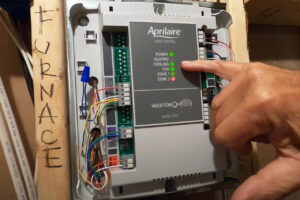 When you step into a comfortable room with the perfect temperature and airflow, have you ever wondered how it’s achieved so effortlessly? The secret lies in the art of control, specifically, the art of pneumatic control in HVAC (Heating, Ventilation, and Air Conditioning) systems. This article will dive into the fascinating world of pneumatic parts from distributors like Orange Coast Pneumatics and how they serve as the unseen architects behind the climate control systems that keep your indoor spaces cozy and energy-efficient.
When you step into a comfortable room with the perfect temperature and airflow, have you ever wondered how it’s achieved so effortlessly? The secret lies in the art of control, specifically, the art of pneumatic control in HVAC (Heating, Ventilation, and Air Conditioning) systems. This article will dive into the fascinating world of pneumatic parts from distributors like Orange Coast Pneumatics and how they serve as the unseen architects behind the climate control systems that keep your indoor spaces cozy and energy-efficient.
Understanding the Basics of Pneumatics in HVAC Systems
Before delving into the intricacies, it is crucial to grasp the basics. Pneumatics is the use of compressed air to transmit and control energy. In the context of HVAC systems, this technology is harnessed to manage temperature and airflow with remarkable precision.
Temperature Regulation through Pneumatics
Imagine you’ve set your thermostat to a comfortable 72 degrees Fahrenheit. Pneumatics ensure that this temperature is not just reached but maintained with remarkable accuracy. Here’s how it works:
Sensors: The process begins with sensors strategically placed throughout the building. These sensors continuously monitor the temperature and send signals to the control system.
Control Valves: Pneumatic control valves, acting as the gatekeepers of airflow, receive these signals. The control valves adjust accordingly depending on whether the temperature needs to increase or decrease.
Compressed Air: Compressed air, the lifeblood of pneumatic systems, is then routed to the appropriate control valve. When the valve opens or closes, it regulates the flow of heated or cooled air, thus maintaining the desired temperature.
This seamless coordination between sensors, control valves, and compressed air ensures that your room stays at the perfect temperature, no matter the weather outside. It’s like having a personal climate butler!
Airflow Control for Enhanced Ventilation
Beyond temperature control, HVAC systems are also responsible for maintaining adequate airflow. Proper ventilation is crucial for ensuring indoor air quality and comfort. Pneumatics excel in this aspect as well:
Dampers: In HVAC systems, dampers control the amount of air entering various parts of the building. Pneumatic actuators are used to adjust these dampers. If a room needs more fresh air, the actuator will open the damper wider, allowing greater airflow.
Fan Speed Control: Pneumatics also play a key role in adjusting fan speeds. When the system detects a need for increased airflow, it signals the fan to operate at a higher speed, improving ventilation without wasting energy.
The Energy Efficiency Advantage
One of the most significant advantages of using pneumatics in HVAC systems is its contribution to energy efficiency. This is achieved through several means:
Precision Control: Pneumatic systems are known for their precise control, ensuring that HVAC components only operate when and to the extent necessary. This prevents unnecessary energy consumption.
Quick Response: Pneumatic actuators can respond rapidly to temperature or airflow requirements changes. This agility allows for efficient adjustments, saving both energy and money.
Reliability: Pneumatic components are durable and have a long service life, reducing maintenance costs and minimizing system downtime.
Zone Control: Pneumatics allow for sophisticated zoning in HVAC systems. Different areas within a building can be independently controlled for temperature and airflow. For instance, if a particular office space doesn’t require heating or cooling, the pneumatic system can redirect the airflow away from that area, conserving energy while maintaining comfort in occupied zones.
Load Shedding: During peak demand periods, electricity costs can soar. Pneumatic systems can be integrated with load-shedding strategies, where non-essential HVAC functions are temporarily scaled back to reduce energy consumption. This not only saves money but also helps stabilize the electrical grid.
Integration with Renewable Energy Sources: Pneumatic control systems are highly adaptable and can seamlessly integrate with renewable energy sources like solar panels and wind turbines. This means that when these clean energy sources are producing power, the HVAC system can adjust to utilize this energy effectively, reducing dependence on fossil fuels.
Occupancy Sensing: Modern pneumatic HVAC systems can incorporate occupancy sensors. When a room is unoccupied, the system can automatically adjust the temperature and airflow to an energy-saving mode, reducing the load on the system until someone enters the room again.
Remote Monitoring and Control: With the advent of smart building technologies, pneumatic HVAC systems can be remotely monitored and controlled. Facility managers can access real-time data and make adjustments as needed, ensuring optimal energy efficiency at all times.
Minimized Heat Loss: In extremely cold climates, maintaining energy efficiency can be a challenge. Pneumatic systems can minimize heat loss by ensuring that heated air is directed precisely where it’s needed, reducing wasteful heat dissipation into unoccupied or non-insulated spaces.
Reduced Carbon Footprint: By conserving energy, pneumatic HVAC systems significantly reduce the carbon footprint of buildings. This not only benefits the environment but also aligns with sustainability goals and may lead to cost savings due to reduced energy bills.
Conclusion
The art of control in HVAC systems, made possible by pneumatics, is a silent yet powerful force that ensures your indoor spaces remain comfortable and energy-efficient. From regulating temperature to managing airflow, pneumatics plays a vital role in creating the perfect indoor environment. So, the next time you step into a perfectly climate-controlled room, you’ll know that it’s not just chance; it’s the artistry of pneumatics at work.


